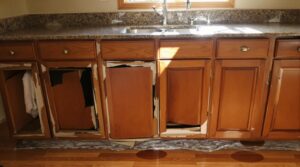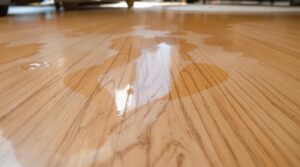Not all wet subfloors require replacement. Minor water damage can often be remedied through proper drying techniques using commercial dehumidifiers and high-velocity air movers. However, replacement becomes necessary when there are signs of extensive rotting, significant warping, or structural weakening. Key indicators include spongy floors, persistent musty odors, or visible mold growth. Professional assessment can determine the best course of action and potentially save thousands in unnecessary replacements.
Key Takeaways
- Not all wet subfloors require replacement – effective drying within 24-48 hours can often save the material from permanent damage.
- Extensive rotting, significant warping, or multiple soft spots indicate irreparable damage that necessitates complete subfloor replacement.
- Professional assessment using moisture meters can determine if drying methods will suffice or if replacement is necessary.
- Signs requiring replacement include spongy feeling underfoot, persistent musty odors, visible mold growth, and structural weakening.
- Commercial dehumidifiers and high-velocity air movers can successfully dry subfloors when damage is caught early.
Signs Your Wet Subfloor Is Beyond Saving
How can homeowners determine when their water-damaged subfloor needs replacement rather than repair? Several critical indicators point to irreparable damage.
When subfloor materials exhibit extensive rotting, significant warping, or structural weakening, replacement becomes necessary. A spongy feeling underfoot or floors that shift when walked on signal serious deterioration beneath the surface. Professional inspection is essential for accurately evaluating water damage severity. In cases where water damage is suspected, timely intervention can prevent more extensive repairs down the line. Homeowners should also consider seeking out leak detection services for flooring to identify underlying issues that may not be immediately visible. Regular maintenance and vigilance can help safeguard the integrity of your flooring and ensure a safe living environment.
Visible signs include bubbling in vinyl or laminate flooring, persistent musty odors, and dark staining that persists even after drying.
When moisture barriers have failed and led to mold growth, health concerns make replacement mandatory. Additionally, if the subfloor shows swelling, sagging, or multiple soft spots, particularly in older installations, these conditions typically indicate damage beyond repair.
Repeated water exposure or delayed response to initial water damage often results in complete subfloor failure.
Common Causes of Subfloor Water Damage
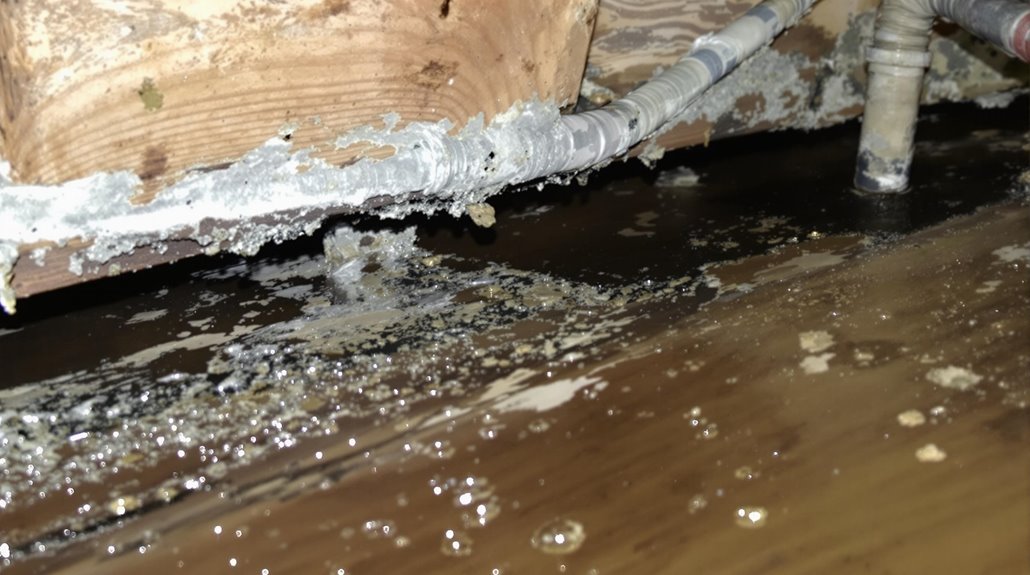
Understanding the common causes of subfloor water damage helps homeowners prevent costly replacements.
Primary culprits include plumbing issues like frozen or aging pipes, leaking appliance hoses, and hidden wall leaks that often manifest as musty odors and mold. When temperatures drop below freezing, expanding ice pressure can rupture pipes and cause severe water damage.
External factors play a considerable role, with improper flood prevention measures such as clogged gutters, poor landscape grading, and inadequate downspout positioning leading to crawl space flooding.
Regular plumbing maintenance is essential, as neglecting routine inspections, ignoring increased water bills, and failing to install leak detection systems can result in extensive damage.
Environmental conditions also contribute greatly, particularly in areas prone to flooding, heavy rainfall, and natural disasters.
Poor foundation design and inadequate waterproofing compound these risks, making homes more susceptible to subfloor water damage.
When Immediate Replacement Is Necessary
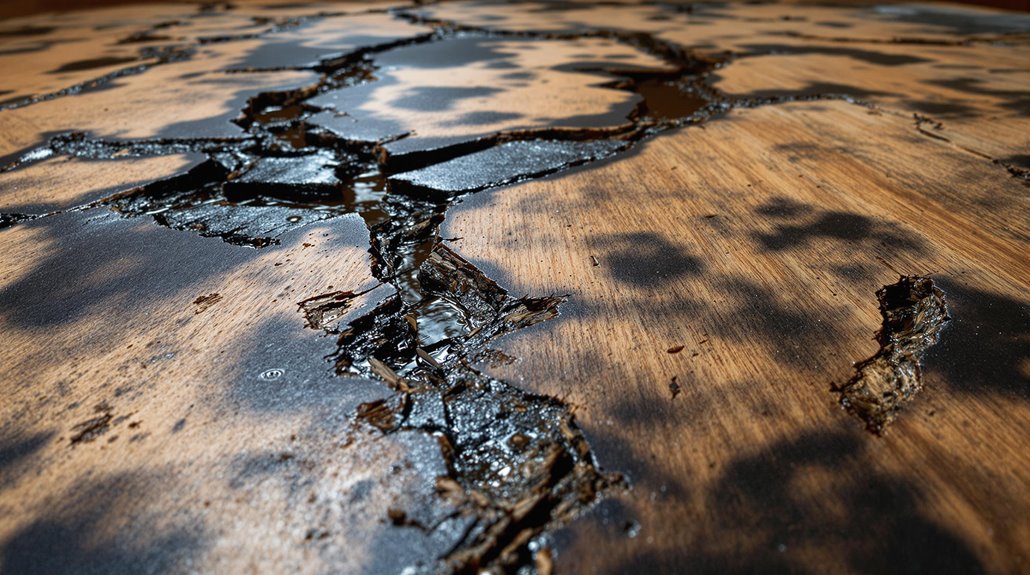
Black water contamination from sewage or flooding requires immediate subfloor replacement due to hazardous pathogens and toxins that can pose serious health risks.
Extended water exposure can cause irreparable damage to subflooring within 24-48 hours if not properly dried and addressed.
Severe structural compromise, evidenced by significant rotting, warping, or weakening of the subfloor material, demands swift replacement to prevent potential collapse and guarantee occupant safety.
These urgent replacement scenarios often require professional assessment and remediation to properly address both contamination risks and structural integrity concerns.
Black Water Damage
When a subfloor encounters black water damage from sewage backups or contaminated floodwater, immediate replacement becomes vital for both structural integrity and occupant safety. The contaminated water introduces harmful pathogens and accelerates material degradation, making effective water mitigation essential. Signs of severe damage include persistent odors, visible staining, and a spongy feel underfoot.
Professional restoration techniques must begin with isolating the affected area to prevent cross-contamination. The process involves thorough assessment of visible damage, moisture levels, and joist condition.
Damaged materials require complete removal, followed by proper decontamination and drying procedures. Implementing preventive measures during replacement, such as waterproof barriers and mold-resistant treatments, helps protect against future incidents.
Regular inspections and proper documentation of the restoration process guarantee long-term protection of the new subfloor installation.
Severe Structural Compromise
Severe structural compromise of a subfloor demands immediate professional attention and complete replacement to prevent catastrophic failure. Key indicators include sagging floors, widespread water absorption, and significant floor joist damage that undermines subfloor stability.
When these issues are accompanied by continuous moisture sources and extensive mold growth, the structural integrity becomes critically compromised.
Professional evaluation becomes essential when there are signs of systematic failure, including severe warping, delamination of materials, and visible gaps between boards.
These conditions indicate the subfloor has lost its load-bearing capacity and can no longer function safely.
Hidden damage may extend beyond visible areas, requiring thorough assessment to determine the full scope of necessary repairs and guarantee compliance with building codes.
Steps to Assess Subfloor Water Damage
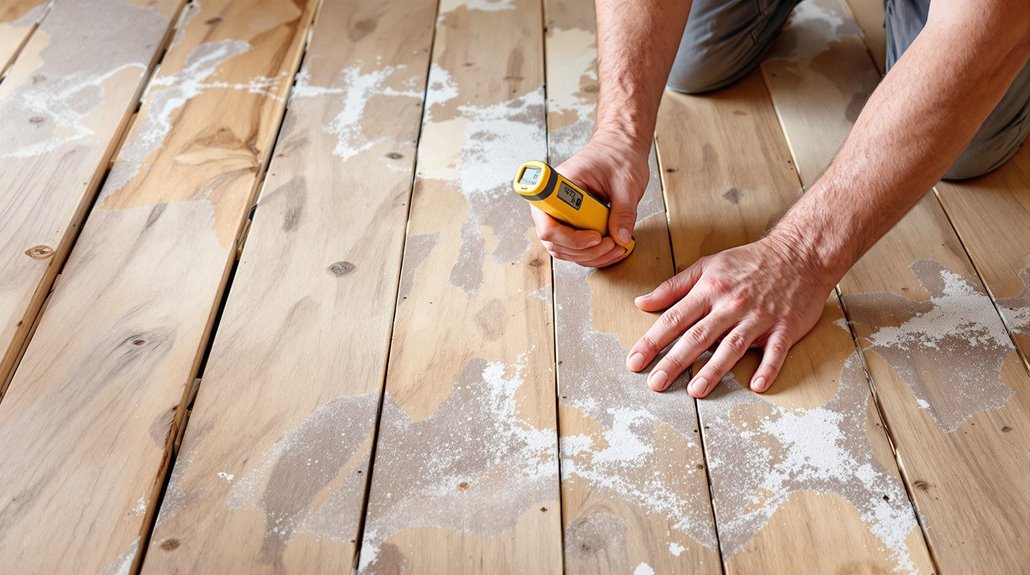
Evaluating water damage in a subfloor begins with identifying visible signs like discoloration, warping, or soft spots in the material.
A moisture meter can accurately measure dampness levels throughout the affected area to determine the full extent of water penetration.
Documenting all damaged sections with chalk markings helps create a clear plan for necessary repairs or replacement while ensuring no problem areas are overlooked during the restoration process.
Visual Signs of Damage
Water damage to subfloors often reveals itself through distinct visual indicators that homeowners and contractors can identify.
During a visual inspection, key signs include discoloration, water stains, and dark patches on the flooring surface. These markers may appear on hardwood, carpet, tile, or laminate materials, often accompanied by loosened tiles or faded areas.
Damage assessment should focus on textural changes like warping, buckling, or cupping of floorboards.
Additional warning signs include bubbling in vinyl or laminate surfaces, and areas that feel spongy underfoot.
Structural concerns become apparent through uneven flooring, noticeable dips, or gaps between the flooring and walls.
The presence of mold or mildew growth typically indicates advanced water damage that requires immediate attention.
Test for Moisture Levels
Beyond visual inspection, accurate moisture testing provides quantifiable data to determine the extent of subfloor water damage.
Several testing methods can deliver reliable results, including RH surface-mounted insulated hood tests, which should indicate maximum humidity of 70%.
Document the Problem Areas
Once moisture levels have been tested, thorough documentation of problem areas becomes essential for planning effective repairs.
Professional subfloor inspection techniques involve marking affected areas with chalk, photographing visible damage, and evaluating structural integrity. During the water damage assessment, inspectors must check for soft spots, discoloration, and signs of mold while examining the condition of underlying floor joists.
- Mark boundaries of damaged areas with chalk and document with detailed photographs
- Test floor stability by checking for soft spots, gaps, and signs of movement
- Inspect joists and support structures for compromised integrity
- Record the extent and location of damage, including any visible mold growth
This systematic documentation helps determine whether partial or complete subfloor replacement is necessary and guides the preparation of appropriate repair strategies.
Drying Methods That Can Save Your Subfloor
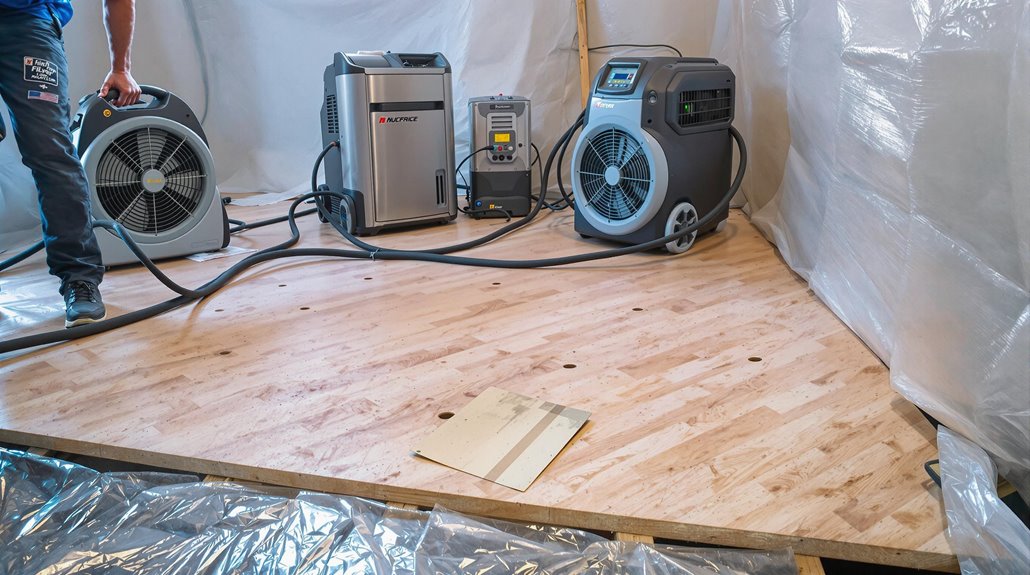
Implementing effective drying methods can often save a water-damaged subfloor from requiring complete replacement. Key drying techniques include using commercial dehumidifiers combined with high-velocity air movers to accelerate moisture removal.
The double-drying method, which involves drilling strategic holes in the subfloor to blow heated dry air into the basement, proves particularly effective for thorough drying.
Temperature control plays an essential role in moisture control, with favorable conditions ranging between 70-90 degrees Fahrenheit during the first 36-48 hours.
Professional-grade dehumidifiers and proper air circulation help maintain these conditions while reducing vapor pressure. Creating drying chambers around affected areas can contain and maintain ideal temperatures.
Regular moisture monitoring through daily readings guarantees the drying process progresses effectively and allows for timely adjustments to the drying strategy.
Key Prevention Strategies for Subfloor Protection
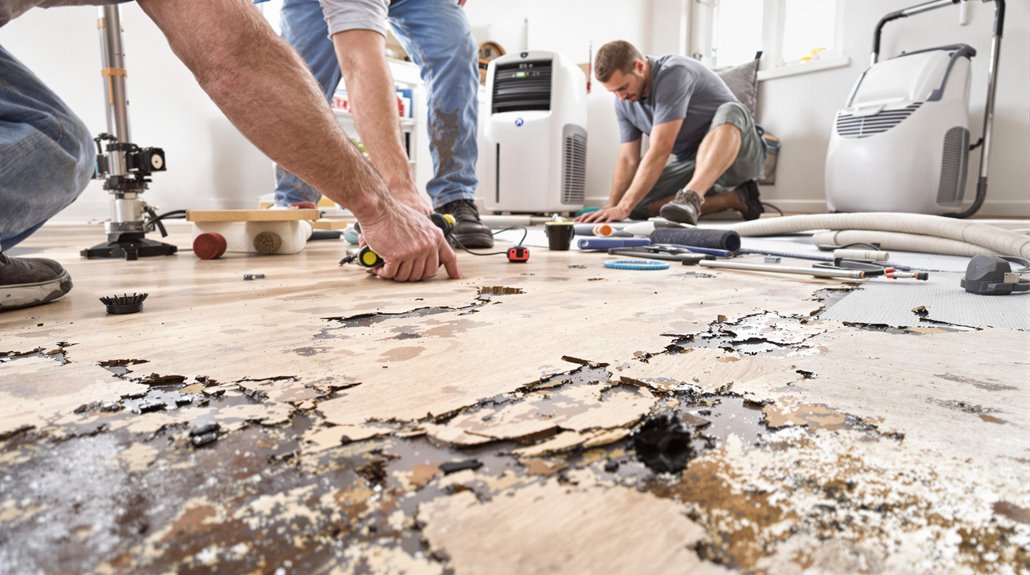
Successful subfloor protection relies on a thorough strategy of pre-installation measures, ongoing maintenance, and proper material selection.
Essential components include moisture barriers and subfloor insulation, which work together to prevent water damage and maintain structural integrity. Professional installation of vapor barriers and waterproofing materials creates a robust defense against ground moisture and potential leaks.
- Conduct extensive moisture testing before installation and apply appropriate primers.
- Install high-quality underlayment and moisture barriers suited to the specific subfloor material.
- Maintain proper ventilation and use dehumidifiers in moisture-prone areas.
- Perform regular inspections of basement areas and crawl spaces to detect early warning signs.
Following these preventive measures greatly reduces the risk of water damage and extends the life of both subfloor and flooring materials.
Professional Assessment and Restoration Options
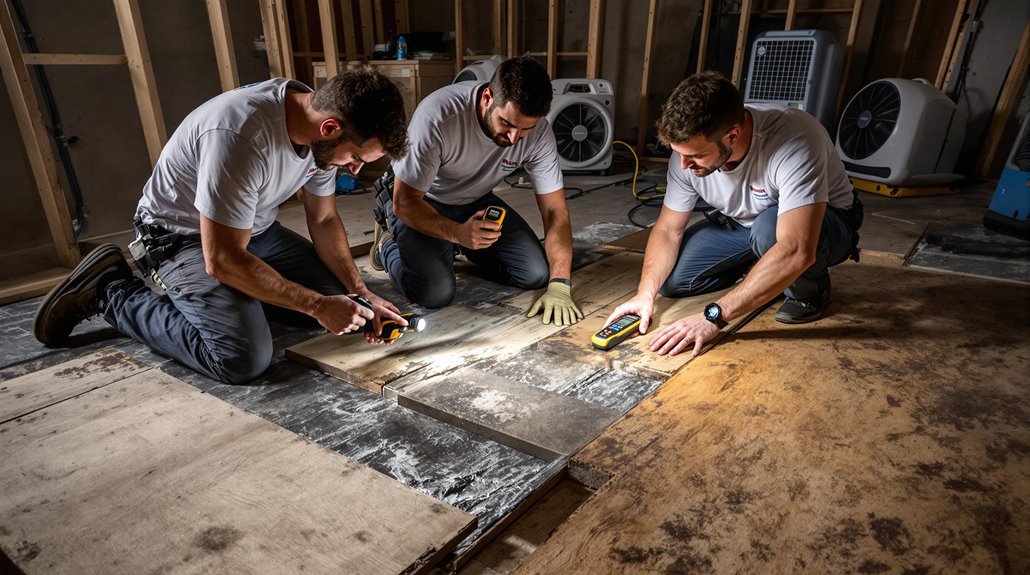
When water damage impacts a subfloor, professional assessment becomes critical for determining the appropriate restoration approach. Experts evaluate multiple factors, including the type of water damage, duration of exposure, and specific subfloor materials affected.
Professional assessment typically involves examining structural integrity, moisture content, and signs of mold growth.
Restoration techniques vary based on damage severity. For minor damage with sound structural integrity, thorough drying and ventilation may suffice. However, extensive structural damage, significant mold growth, or contamination from hazardous water sources requires replacement.
Additionally, professionals consider the cost-effectiveness of repair versus replacement, factoring in both materials and labor expenses. They also assess potential long-term consequences of chosen restoration methods to guarantee the solution addresses both immediate concerns and future stability.
The Benefits Of Consulting A Public Adjuster
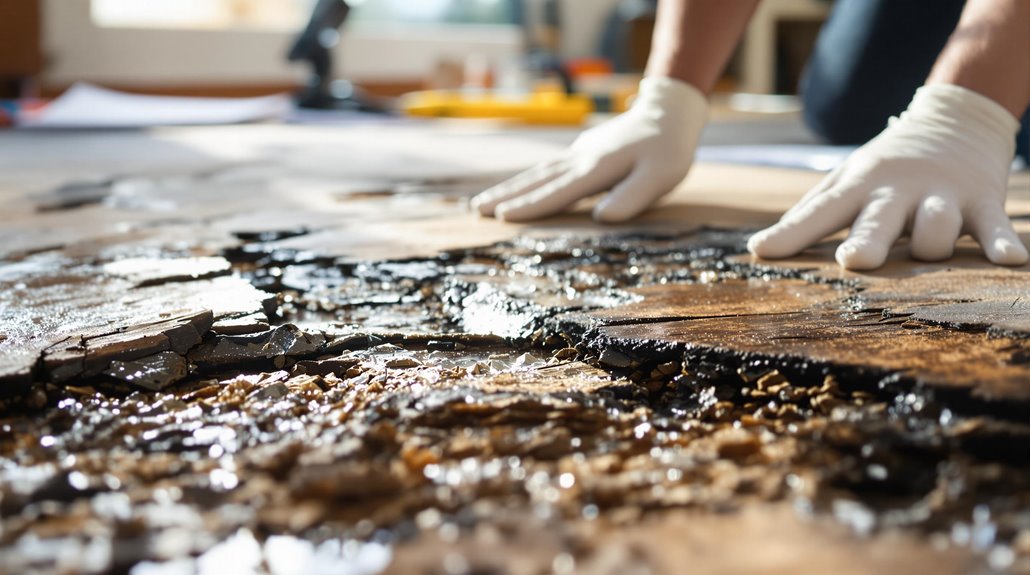
When dealing with water damage to subfloors, timing is crucial, and statistics show that working with public adjusters increases settlements by up to 500% for non-catastrophic claims.
Expertise In Insurance Claims
Managing insurance claims for wet subfloor damage can be considerably more effective with the expertise of a public adjuster. Their extensive knowledge of insurance policy interpretation and claims process efficiency guarantees favorable outcomes for property owners facing water damage issues.
Public adjusters provide essential expertise through:
- Thorough evaluation of policy coverage specific to subfloor water damage, identifying all applicable benefits and coverage limits.
- Professional documentation of damage extent, including detailed assessments and supporting evidence for maximum claim value.
- Strategic negotiation with insurance carriers to secure fair compensation for both replacement costs and associated damages.
- Efficient management of paperwork, deadlines, and communication channels, reducing processing time and potential claim denials.
These professionals navigate complex claim procedures while property owners focus on restoration efforts, ultimately maximizing settlement outcomes through their specialized knowledge.
Unlike insurance adjusters who represent companies, public adjuster fees are based on a percentage of the final settlement, ensuring their interests align directly with the property owner's goals.
Objective Damage Assessment
Public adjusters bring scientific precision to water damage evaluations through objective damage assessment protocols.
Using advanced tools like moisture meters and thermal imaging, they can detect hidden water damage in subfloor materials and compromised moisture barriers that might escape untrained observation.
Their thorough assessments document both visible and concealed damages, guaranteeing that insurance claims account for all necessary repairs.
By identifying issues like seepage into structural components and potential mold growth, public adjusters help prevent undervaluation of claims.
Their expertise proves particularly valuable when evaluating wet subflooring, as they can determine whether replacement is necessary based on scientific data rather than surface-level observations.
This objective approach supports fair compensation and guarantees policyholders receive sufficient funds for proper restoration of water-damaged subflooring.
Operating on contingency fee basis, public adjusters typically charge 5-20% of the final settlement amount while delivering expertise that often leads to higher claim payouts.
Streamlined Claim Process
Every aspect of the insurance claims process becomes more efficient when working with a public adjuster. When dealing with water-damaged subfloor materials and compromised moisture barriers, public adjusters streamline documentation, manage deadlines, and handle complex negotiations with insurance companies.
Their professional expertise guarantees thorough damage assessment and fair compensation for necessary repairs.
- Handles all paperwork and documentation requirements for subfloor replacement claims
- Manages communication between contractors, insurance companies, and property owners
- Expedites claim resolution to prevent further damage from delayed repairs
- Guarantees accurate evaluation of moisture barrier damage and associated repair costs
Their extensive management of the claims process allows property owners to focus on immediate concerns while guaranteeing all aspects of water damage restoration are properly addressed and compensated through insurance coverage. With strict ethical standards required for membership in networks like PCAN, property owners can trust they're working with professionals committed to fairness and transparency.
Higher Claim Payouts & Settlements
Beyond the efficiency of claims processing, property owners gain significant financial advantages when partnering with public adjusters for wet subfloor damage claims.
Statistical evidence demonstrates that professionally adjusted claims typically result in higher settlements, with average payouts increasing by several thousand dollars compared to self-managed claims.
Public adjusters leverage their expertise in claim negotiation and thorough understanding of insurance entitlements to maximize compensation.
Their detailed damage assessments guarantee no aspects of subfloor damage go unnoticed or undocumented.
Working on a contingency basis, these professionals are inherently motivated to secure the highest possible settlements.
Case studies consistently show significant increases in payout amounts, often transforming initial offers of $80,000 into final settlements exceeding $120,000, demonstrating the tangible financial benefits of professional representation.
With commission rates typically ranging from 5% to 15% of the final settlement, public adjusters remain committed to maximizing claim values while maintaining cost-effectiveness for property owners.
About The Public Claims Adjusters Network (PCAN)
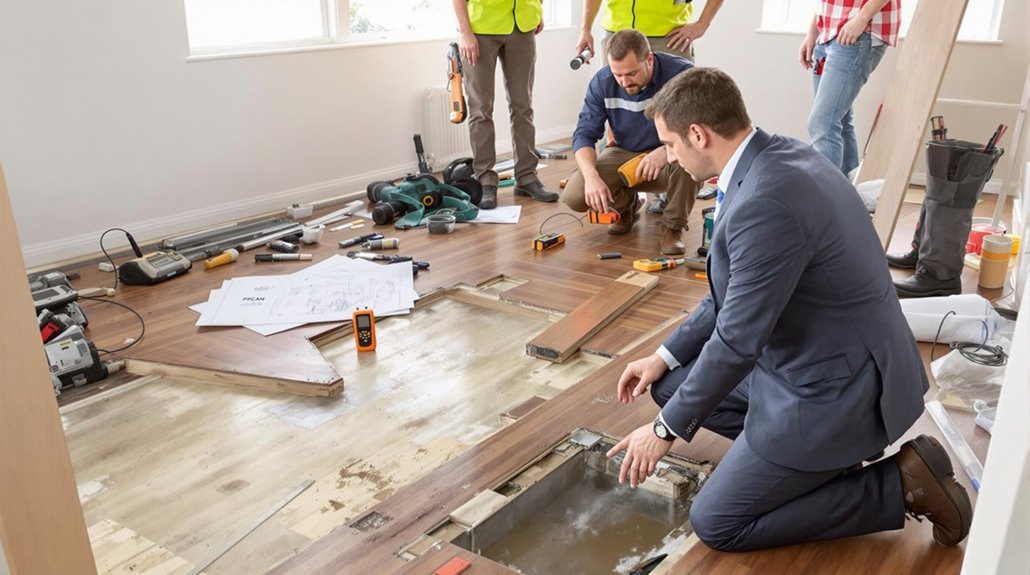
The Public Claims Adjusters Network (PCAN) represents a collective of licensed professionals dedicated to advocating for policyholders during insurance claims processes.
These experts specialize in managing complex claims and insurance negotiations, ensuring clients receive fair treatment and maximum settlements for property damage.
PCAN professionals offer several key advantages:
- Access to a nationwide network of experienced adjusters who understand local regulations and market conditions
- Specialized knowledge in policy interpretation and claim documentation across multiple insurance carriers
- Established relationships with contractors, engineers, and other professionals needed during claims assessment
- Proven track record in successful insurance negotiations and dispute resolution
Through PCAN's thorough approach, policyholders gain expert representation throughout their entire claims process, from initial damage assessment to final settlement.
Frequently Asked Questions
How Long Does a Properly Installed Subfloor Typically Last Before Needing Replacement?
While installation factors can vary results, a properly installed subfloor typically maintains its structural integrity for 20-30 years under normal conditions before requiring replacement, assuming regular maintenance and moisture protection.
Can Insurance Cover Subfloor Replacement if Damage Occurred From Natural Disasters?
Insurance typically covers subfloor replacement from natural disasters, but coverage depends on policy type. Standard policies cover fire and storm damage, while flood insurance claims specifically address water damage.
What's the Average Cost Difference Between Repairing Versus Replacing a Subfloor?
While repair costs typically range from $500-$2,000, full subfloor replacement averages $1,500-$5,000. Surprisingly, the cost difference can reach $3,000 depending on damage severity and room location.
Are Certain Subfloor Materials More Resistant to Water Damage Than Others?
LP Legacy subflooring with water-resistant materials and Gorilla Glue Technology offers superior moisture protection, followed by plywood which dries faster than standard OSB when exposed to water damage.
How Soon After Installation Can You Safely Walk on a New Subfloor?
Most subfloor installations allow light foot traffic after 24 hours, with full traffic permitted after adhesives and fasteners have completely set, typically within 48-72 hours following proper installation tips.
References
- https://50floor.com/blog/replace-or-repair-water-damaged-floors/
- https://kicrestoration.com/what-4-reasons-why-wet-subfloor/
- https://resources.rwsupply.com/guide/water-damaged-floors-guide-can-you-save-water-damaged-wood-flooring-after-a-leak-or-flood/
- https://www.bessemeter.com/blog/subfloor-issues/
- https://rainbowrestores.com/blog/do-i-need-to-replace-my-water-damaged-subfloor
- https://www.baycrawlspace.com/what-to-do-about-water-damaged-subfloor/
- https://restorationmasterfinder.com/restoration/replace-water-damage-subflooring/
- https://www.bobvila.com/articles/signs-of-water-damage-under-floor/
- https://www.budgetdumpster.com/blog/when-to-replace-subfloor
- https://housecashin.com/knowledge-base/water-damage-statistics/






